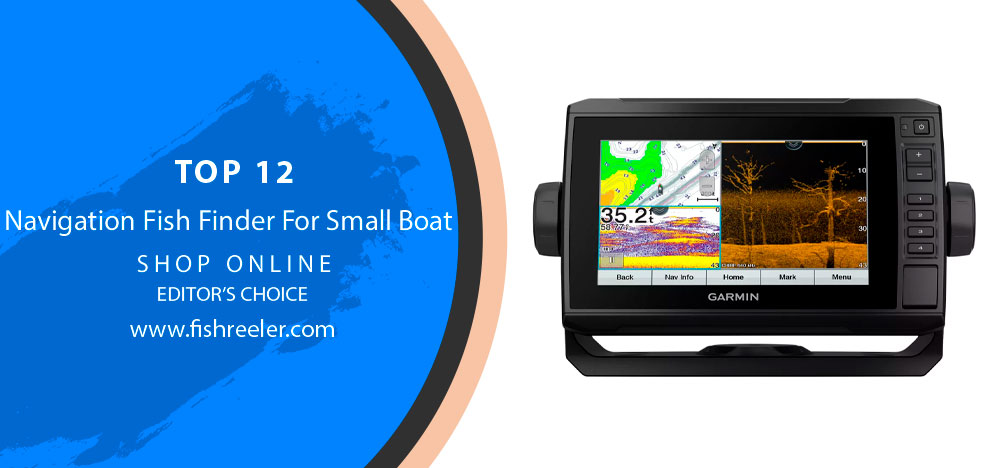
Fish Finder Breakdown: Enhancing Your Small Boat Fishing Adventure
Traditional fishing on a small boat involves a lot of waiting and hoping. You cast your line and patiently anticipate the tug of a fish. But what if you could know where the fish are, their size, and even the type? That’s the magic a fish finder brings to your small boat fishing experience.
With a fish finder, your fishing becomes more efficient and productive. You save time searching for fishing spots and spend more time actually fishing. It enables you to access information that would otherwise be impossible to know, helping you make more strategic decisions on where and when to cast your line.
Furthermore, fish finders designed for small boats consider the space constraints and power requirements, ensuring they complement rather than hinder your fishing setup.
Dive into the World of Navigation Fish Finders: Everything You Need to Know
Navigating a small boat can be both thrilling and daunting, especially when you are exploring unfamiliar waters. One of the key challenges that boaters face is locating fish and understanding the underwater terrain. Luckily, technology has made this task easier and more efficient with the invention of fish finders.
Fish finders have become an essential tool for both professional and recreational fishermen, allowing them to locate fish and understand underwater features such as depth, temperature, and structure. In this blog post, we will discuss how fish finders can help navigate a small boat and what features to consider when choosing the best fish finder for your needs.
With the ability to locate fish and underwater structures, fish finders have revolutionized the way we approach fishing. In addition to providing fish location data, fish finders can also help navigate a small boat, ensuring safe travels on the water. However, with so many options available on the market, it can be overwhelming to choose the right fish finder for your specific needs.
This post will explore the key features to consider when selecting a fish finder for a small boat, including screen size, frequency, and power. There are many choices when it comes to selecting a fish finder, and it can be difficult to determine which one is the best for your needs. If you have a small boat, then a navigation fish finder is probably the best option for you. These devices are specifically designed to help you locate fish and navigate your way around obstacles in the water.
Navigating Unfamiliar Waters: Using Your Fish Finder for Safe Travels
Navigation fish finders have become an essential tool for both professional and recreational fishermen. With the ability to locate fish and underwater structures, fish finders have revolutionized the way we approach fishing.
In addition to providing fish location data, fish finders can also help navigate a small boat, ensuring safe travels on the water. When selecting the perfect fish finder for your small boat, it’s important to consider key features such as screen size, frequency, and power.
Understanding Screen Size: Why Bigger Isn’t Always Better. Screen size is an important consideration, as it determines how much detail you’ll be able to see on the screen. A larger screen size allows for more detailed imagery, which can be useful when navigating unfamiliar waters.
Frequency Matters: Finding the Right Fish Finder for Your Fishing Style. Frequency is another important consideration, as it determines how far down the fish finder can see. Lower frequencies can see deeper into the water, making them ideal for deep-sea fishing, while higher frequencies are better suited for shallow waters.
Power Up Your Fishing Game: Selecting the Right Wattage for Your Navigation Fish Finder. Power is also important, as it determines how far the fish finder can send and receive signals. A higher wattage means a more powerful signal, which can be useful in deeper waters.
Diving into the Depths: How Navigation Fish Finders Work on Small Boats
A navigation fish finder for a small boat works by sending sound waves or sonar into the water and detecting the reflected signals from objects, such as fish or the bottom of the waterway. The unit then translates these signals into an image or graph that can be interpreted by the user.
To use a fish finder, you’ll need to install a transducer on the hull of your boat, which sends out the sonar signal. The signal travels through the water and bounces back to the transducer, which sends the information to the fish finder unit.
Once the sonar data is received, the fish finder uses algorithms to analyze the data and create a visual representation of the underwater environment. This can include the depth of the water, the location of the fish, and the structure of the bottom.
Many navigation fish finders also come with GPS technology, allowing you to mark waypoints, navigate to specific locations, and keep track of your position on the water.
Maximizing Your Catch: Tips and Tricks for Using Your Navigation Fish Finder
A navigation fish finder can be a powerful tool for enhancing your fishing experience, but it can take some practice to master. Here are some tips and tricks for using your navigation fish finder to its full potential:
- Adjust the sensitivity: The sensitivity of your fish finder determines how it responds to signals. If it’s too low, you might miss fish, but if it’s too high, you might see too many false signals. Adjust the sensitivity until you get a clear and accurate reading.
- Understand the sonar readings: The sonar readings on your fish finder can be complex, but understanding them is key to finding fish. Take the time to learn what the different shapes and colors mean and how they correspond to fish, structures, and other underwater features.
- Pay attention to water temperature: Water temperature can have a big impact on where fish are located. Use your fish finder’s temperature gauge to find areas with a temperature that is attractive to your target species.
- Use GPS to mark waypoints: Many navigation fish finders come with GPS capabilities, allowing you to mark waypoints where you find fish or other interesting underwater features. This can help you navigate back to those locations in the future.
- Practice, practice, practice: The more you use your navigation fish finder, the better you’ll become at interpreting the readings and locating fish. Practice in different types of water and with different target species to become a master at using your fish finder.
Navigating the World of Fish Finders: A Guide to Choosing the Right Type for You
| Type of Fish Finder | Explanation |
|---|---|
| Standalone Fish Finder | A standalone fish finder is a basic unit that displays only sonar information. It can be mounted anywhere on the boat and is powered by a separate battery or power source. Some standalone models may have GPS capabilities, but they don’t offer the advanced features of more expensive models. |
| Combination Fish Finder and GPS | A combination fish finder and GPS unit combines the sonar capabilities of a fish finder with GPS navigation functions. This type of unit is ideal for anglers who want to track their location, mark fishing hotspots, and navigate to specific points on the water. |
| Networked Fish Finder | A networked fish finder connects to other electronic devices on the boat, such as a chartplotter or radar, to provide a complete navigation system. This type of unit allows for more advanced features like overlaying sonar data on a chartplotter display and sharing information between devices. |
| Portable Fish Finder | A portable fish finder is a compact, battery-powered unit that can be easily transported between boats or used from shore. It typically uses a transducer that can be cast into the water or attached to the hull of a small boat. Portable fish finders are a good option for anglers who fish from multiple locations or don’t want to permanently mount a fish finder on their boat. |
By understanding the different types of fish finders available, you can choose the one that best fits your needs and budget. Consider factors such as the size of your boat, the type of fishing you’ll be doing, and the features you require when making your selection.
🎦Video YouTube: Best Fish Finder for Small Boats, Kayaks, or Canoes
Best Navigation Fish Finder For Small Boat Review
Are you looking for the best fish finder for a small boat? If so, you’re in luck, because we’ve compiled a list of the top-rated navigation fish finders on the market today. Whether you’re a seasoned fisherman or just getting started, these devices will help you locate and track fish with ease. So what are you waiting for? Read on to learn more about these handy gadgets!
Look no further than a navigation fish finder for your small boat. With this essential tool, you can not only locate fish but also understand the underwater terrain and ensure safe travels on the water.
From screen size to frequency to power, we’ll cover all the key features to consider when selecting the perfect fish finder for your next fishing trip. So grab your boat, and your fishing gear, and get ready to take your fishing game to the next level with a navigation fish finder.
1# Humminbird PiranhaMAX 4 Fishfinder
Looking for the best fishfinder for the money? Look no further than the Humminbird PiranhaMAX 4 Fishfinder. This powerful device comes packed with features and capabilities that serious anglers need, including aDual Beam depth capability of 600′, a crisp 256-colour screen with 480×272 resolution, and 2,400W PTP power output. The Humminbird PiranhaMAX 4 Fishfinder also features a stylish design and convenient tilt-mount base, making it easy to use and transport. Whether you’re an experienced fisherman or just getting started, the Humminbird PiranhaMAX 4 Fishfinder is a great choice for anyone looking for an affordable, reliable fishfinder.
2# Lowrance HOOK2 4X Bullet GPS Plotter Fishfinder
The Lowrance HOOK2 4X Bullet GPS Plotter Fishfinder is the world’s easiest fishfinder/GPS plotter, with exclusive technologies for novices and pros alike. With a 4″ SolarMAX Screen, the Ultra-crisp display with sunlight-viewable brightness is perfect for fishing in any condition. The Autotuning sonar—active, automatic adjustments for peak performance as conditions change—provides the best sonar performance without having to adjust any settings. The proven Lowrance Broadband sonar has double the sonar coverage of traditional fishfinders, making it easy to find fish.
3# Garmin Striker 4 Sonar Fishfinder and GPS Plotter
The Garmin Striker 4 Sonar Fishfinder and GPS Plotter is a top-of-the-line device that provides anglers with everything they need to find and catch fish. The 3.5″ colour display is easy to use, and the built-in, high-sensitivity GPS ensures you always know where you are on the water. The CHIRP sonar gives you crystal-clear images of what’s beneath the surface, while the HD-ID™ sonar ensures you can see even the smallest details. You can also mark hot spots, docks and ramps to return to later.
4# HawkEye FishTrax 1C Color Handheld Fishfinder
Introducing the HawkEye FishTrax 1C handheld fishfinder – perfect for anyone who loves spending time on the water! This powerful little fishfinder features dual-beam Intelligent Sonar, which can help you quickly and easily locate your target fish. The 100-level adjustable sensitivity ensures you’ll get accurate readings every time, while the multi-level depth ranges let you explore different depths of water. Plus, the auto-zoom bottom tracking function makes sure you never lose sight of your catch! The included transducer is also specifically designed to work with the HawkEye FishTrax 1C, so you can start fishing right away.
5# Humminbird PiranhaMAX 4 DI Fishfinder
Looking for a powerful and easy-to-use fishfinder? Look no further than the Humminbird PiranhaMAX 4 DI Fishfinder. Featuring a 4.3″ screen, this fish finder is 20% larger than past versions, making it easier to read and interpret your data. The 256-colour screen is crisp and clear, with a resolution of 480×272. Down Imaging technology allows you to see up to 320′ below the surface, while Dual Beam technology gives you a 600′ view. With 2,400W PTP power output, this fish finder can handle anything you throw at it. And the convenient tilt-mount base makes it easy to install and use.
6# Garmin STRIKER Vivid 4cv Fish Finder
The STRIKER Vivid 4cv Fishfinder from Garmin is easy-to-use and provides updated, more-vivid colour palettes for greater contrast that makes fish and structure easily distinguishable. This great fish finder also includes the GT20 transducer for built-in Garmin CHIRP traditional sonar and CHIRP ClearVü scanning sonar. It has a high-sensitivity GPS to mark waypoints, create routes, and view your boat’s speed. The STRIKER Vivid 4cv Fishfinder is perfect for any fishing enthusiast!
7# Lowrance HOOK2 4X Bullet GPS Plotter Fishfinder with All Season Pack
Introducing the Lowrance HOOK2 4X Bullet GPS Plotter Fishfinder with All Season Pack. This full-featured portable fish finder is perfect for small boats, kayaks, canoes, ice fishing, and more. The 4″ SolarMAX Screen provides an ultra-crisp display with sunlight-viewable brightness, and the autotuning sonar actively and automatically adjusts for peak performance as conditions change. The proven Lowrance Broadband sonar provides 200kHz sonar mode for easy fishfinding, double the sonar coverage of traditional fishfinders, and optimized keypad access to key features. The high-sensitivity GPS antenna saves waypoints, follows trails, and navigates to your favourite spots.
8# Humminbird HELIX 5 CHIRP GPS G2 Fish Finder/Chartplotter
The Humminbird HELIX 5 CHIRP GPS G2 Fish Finder/Chartplotter is a top-of-the-line product that features AutoChart Live, which creates real-time maps of your fishing spots. This product is also compatible with optional mapping upgrades, so you can future-proof your fishing command centre.
9# Humminbird Helix 7 CHIRP MEGA SI GPS G3N Fishfinder/Chartplotter
Introducing the Humminbird Helix 7 CHIRP MEGA SI GPS G3N GPS Fishfinder/Chartplotter. This powerhouse fish finder is designed for serious anglers who demand the best in terms of performance and features. The vivid, 7″ display provides impressive views of underwater structures and fish, while the MEGA Side Imaging and MEGA Down Imaging technologies allow you to see more of what’s going on beneath the surface. The Dual Spectrum CHIRP and Low Q CHIRP transducer provide exceptional sonar performance, while the SwitchFire Sonar dual display modes give you the flexibility to customize your display according to conditions.
10# Simrad Cruise 7 Fishfinder/Chartplotter with 83/200 Transducer
Simrad’s Cruise 7 Fishfinder/Chartplotter is the perfect tool for serious anglers who demand easy operation and intuitive controls. Featuring full-function CHIRP sonar plus precise GPS navigation, sunlight-viewable displays, crisp 800×480-pixel resolution, and selectable, arrangeable full- and split-screen views, the Cruise 7 provides everything you need to find fish fast. Additionally, its pre-loaded C-MAP US Coastal map and worldwide base map make it easy to find your way around, while its one 32GB Micro SD slot provides plenty of room for enhanced mapping options.
11# Garmin ECHOMAP UHD 73cv Fish Finder/Chartplotter Combo
Looking for a top-of-the-line fish finder/chartplotter combo that won’t break the bank? Check out the Garmin ECHOMAP UHD 73cv. This unit comes packed with features including a bright, sunlight-readable 7″ touchscreen display, keyed assist, preloaded LakeVü g3 inland maps with integrated Navionics data, support for Panoptix all-seeing sonar, and more. Plus, it’s easy to take on the go thanks to the quick-release bail mount. Whether you’re a seasoned angler or just getting started, the ECHOMAP UHD 73cv is a great choice for anyone looking for a high-quality fish finder at an affordable price!
12# HydroWave H2 Mr. Crappie Electronic Fishing Call Package
The HydroWave H2 Mr. Crappie Electronic Fishing Call Package is a powerful fish-attracting electronic call package that includes 8 live-action sounds of crappie feeding and baitfish. All sounds are approved by Mr. Crappie, and Wally Marshall. The package includes the Mr. Crappie unit, waterproof speaker, unit and speaker mounting hardware, user guide, and warranty card. Live-action sounds include Brushpile Majic, Spider Rigging – Frenzy, Tight Line – Finesse, Bait Balls, Busting Shad, Finesse, Power Trolling Frenzy, and Vertical Structure.
Installation Made Easy: Setting Up Your Navigation Fish Finder on a Small Boat
Installing a navigation fish finder on a small boat can seem daunting, but with the right tools and some basic knowledge, it can be a straightforward process. Here’s a step-by-step guide to help you set up your navigation fish finder on a small boat:
- Choose the right location: The transducer, which sends out sonar signals to detect fish and other underwater features, should be mounted on the bottom of the boat where it can get an unobstructed view of the water. Make sure to choose a location where it won’t be damaged by rocks, debris, or the boat’s propeller.
- Install the transducer: Mount the transducer on the chosen location using the included hardware and make sure it’s level with the bottom of the boat. Then, run the transducer cable through the boat’s hull and secure it with clamps.
- Mount the display unit: Choose a location for the display unit where it can be easily viewed and accessed while operating the boat. Mount it securely using the included hardware.
- Connect the transducer cable: Connect the transducer cable to the display unit according to the manufacturer’s instructions. Make sure the connections are secure and tight.
- Power up and test: Connect the power cable to a battery or power source and turn on the fish finder. Follow the manufacturer’s instructions to set up the unit and test it to make sure it’s working properly.
By following these steps, you can install your navigation fish finder on a small boat and start using it to enhance your fishing experience. Always refer to the manufacturer’s instructions for specific installation and operation details.
Troubleshooting Your Navigation Fish Finder: Common Problems and Solutions
As with any electronic device, there may be times when your navigation fish finder experiences problems or malfunctions. Here are some common issues you may encounter when using your fish finder, along with potential solutions:
- No power: If your fish finder won’t turn on, check the power source and make sure it’s properly connected. If it’s battery-powered, make sure the batteries are fully charged or replace them with new ones.
- No display: If the fish finder has power but the display is not showing any information, check the connections between the display and the transducer. If the connections are fine, the display unit may need to be replaced.
- False readings: If your fish finder is giving you false readings, adjust the sensitivity settings and make sure the transducer is positioned correctly. Also, check for any debris or air bubbles around the transducer, which can cause false readings.
- No or weak signal: If the signal is weak or nonexistent, check the transducer and make sure it’s properly installed and positioned. Also, check for any damage to the transducer cable or connection points.
- Interference: If you’re experiencing interference or noise on the display, try adjusting the frequency settings or moving the fish finder away from other electronics on the boat.
The Importance of SOS Security Features in Your Navigation Fish Finder
SOS security features are essential for any boater, whether they are operating a large vessel or a small boat. These features can help ensure the safety and security of everyone on board by providing communication and navigation capabilities in case of an emergency. Here are some of the most important SOS security features to consider when choosing a navigation fish finder for your small boat:
- Emergency Alerting System: An emergency alerting system is a critical component of any SOS security feature. This system can include an EPIRB (Emergency Position Indicating Radio Beacon) or a PLB (Personal Locator Beacon) that can be activated in case of an emergency. When activated, these devices send out a signal to search and rescue authorities, providing your location and other critical information that can help rescuers find you quickly.
- GPS: A Global Positioning System (GPS) is a must-have feature for any navigation fish finder. This technology allows you to pinpoint your location on a map, making it easier to navigate and also helping in case of an emergency. If you ever get lost or stranded, having a GPS on board can help rescuers find you more easily.
- Automatic Identification System (AIS): AIS is a technology that allows boats to communicate with each other, exchanging information about their location, course, and speed. Having an AIS system on board can help you avoid collisions and keep track of other boats in the area. In case of an emergency, AIS can also help rescuers locate your boat more easily.
- Fish Finder: While a fish finder may not seem like an essential SOS security feature, it can be helpful in certain situations. For example, if you become stranded in a remote area, a fish finder can help you locate areas where fish are likely to be found, increasing your chances of catching food to sustain yourself until help arrives.
By choosing a system that includes emergency alerting capabilities, GPS, AIS, and a fish finder, you can enjoy peace of mind knowing that you are prepared for any situation that may arise.
Maximizing Your Safety with SOS Features on Your Navigation Fish Finder
Don’t leave shore without it: SOS security features for your fish finder. SOS security features, navigation, and fish finders are all essential tools for small boat owners. These features can help ensure your safety while out on the water, help you navigate your surroundings, and assist you in finding fish and other marine life.
SOS security features: how technology can save your life on the water. When it comes to safety on the water, an SOS feature is a must-have for any small boat owner. In case of an emergency, an SOS feature can help you quickly and easily send out a distress signal. Many modern SOS systems come with GPS technology, which means that the signal sent out will include your exact location. This can be a lifesaver in the event of an accident or other emergency situation.
Navigation is an essential feature for any small boat owner. Whether you’re fishing, exploring, or simply enjoying the water, you need to know where you are and where you’re going. A good navigation system will help you chart your course and make sure you don’t get lost. Many modern navigation systems come with GPS technology, which means that you can see your exact location on a map in real time. Some systems also come with pre-loaded maps and charts, so you can easily find your way around even in unfamiliar waters.
FAQ: Navigating the Depths
The Future of Fishing: Advances in Navigation Fish Finder Technology
In conclusion, if you are a small boat owner looking to improve your fishing experience and navigate unfamiliar waters with confidence, a navigation fish finder is the perfect tool for you. With advanced technology and features such as detailed imaging, depth sensing, and power signal strength, these devices have revolutionized the way we approach fishing.
By taking the time to consider the key features that are important to you, you can select the perfect fish finder for your specific needs and increase your chances of a successful and safe fishing trip. So why wait? Start exploring the options today and discover the benefits of a navigation fish finder for your small boat.
If you’re looking for a fish finder that is specifically designed for small boats, then a navigation fish finder is the best option for you. These devices come with many features that are helpful for navigating your way around obstacles in the water. We’ve compiled a list of the top-rated navigation fish finders on the market today, so read on to learn more about them!

I live in Tenerife (Canary Islands) for the last 10+ years and share my daily fishing experiences on my website. Many years of personal experience as a fisherman and the vast experience of my friends allow me to write professionally on any fishing topics (from choosing a flashlight and equipment to deep-sea fishing).
All of my advice is based on practical real-world experience and will be useful to both novice anglers and professionals. Read more about the author.
Affiliate Disclosure: FishReeler.org sometimes gets paid for listings, through sponsors or affiliate programs like Amazon, Ebay, Cabelas, Bass Pro Shop, Shimano, Daiwa, Rapala, Renn, Okuma, KastKing, etс. Clicking a link helps keep FishReeler.org free, at no extra cost to you!
About the author: Each article is verified by the fishing expert Sergio Smirnoff. The articles are written by professional and amateur fishermen with 20+ years of fishing experience.
Note: The views and opinions expressed in this article are those of the authors and do not necessarily reflect the official policy or position of any agency. The articles are for informational purposes only, share your opinions in the comments and join the fishing discussions, let's share our fishing experiences together!

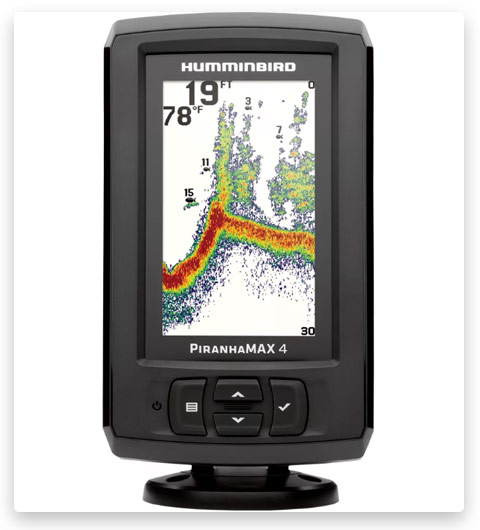


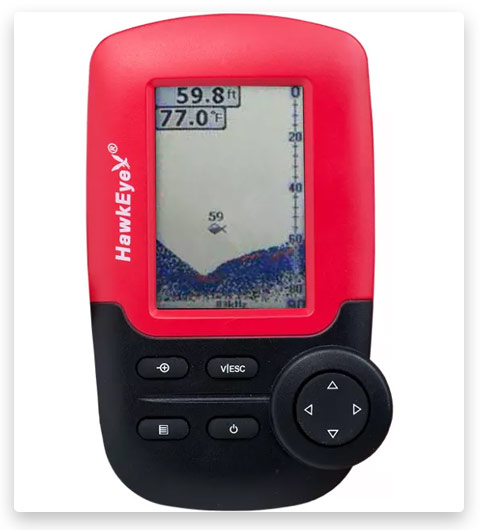
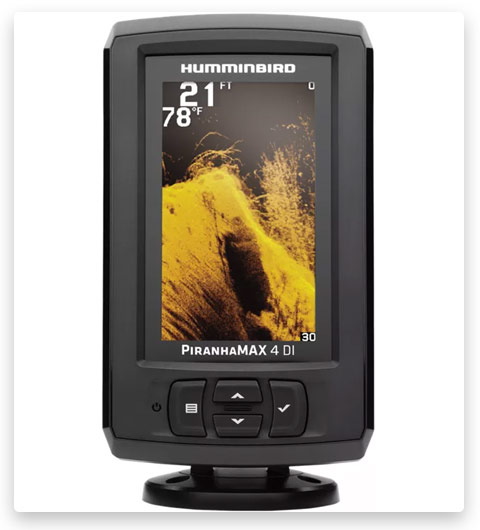

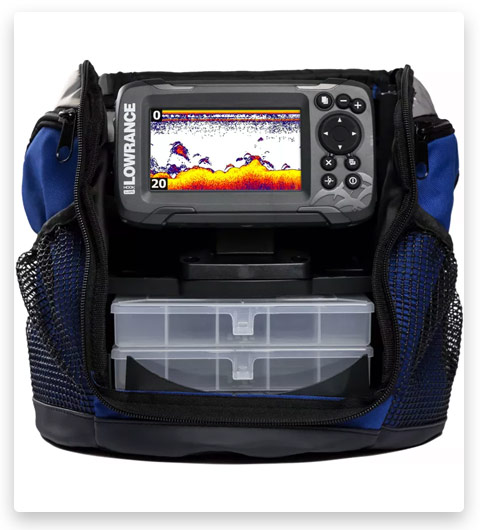
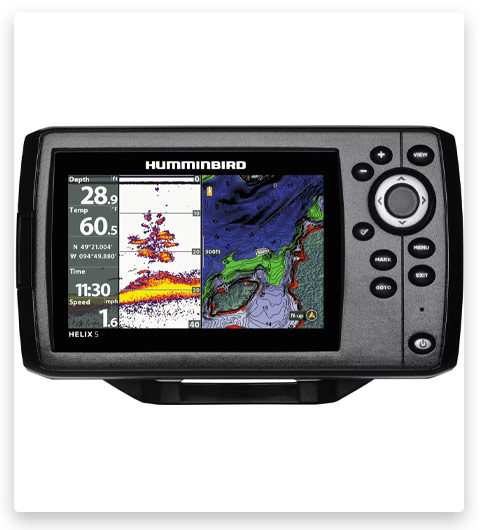
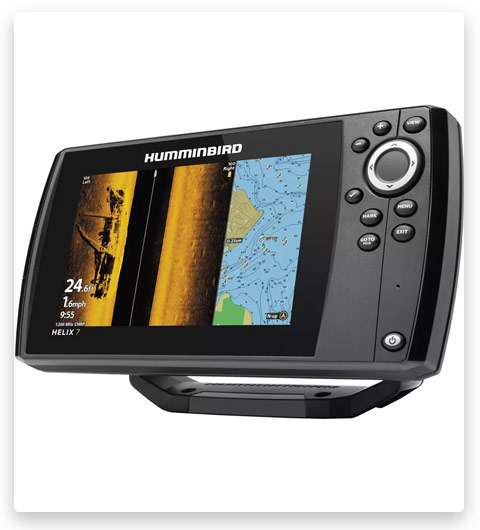



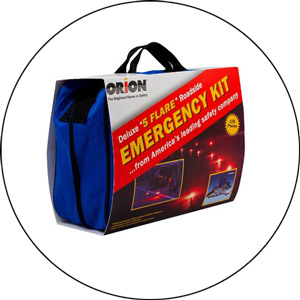

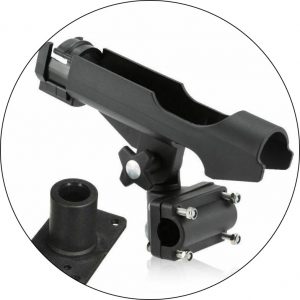
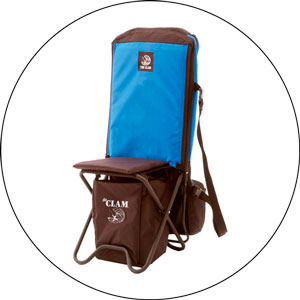


If you’re in the market for a fish finder for your small boat, then you’ll want to check out some of my favorite brands. Each one has its own unique features, so it’s important to research and find the right one that will suit your needs.
Humminbird is a top contender with its high-tech features that can enhance your fishing experience. They have a variety of fish finders that will work well for any type of boat or water.
Lowrance is another well-known brand that is known for producing high-quality fish finders. With their variety of sizes, colors, frequencies, and cone angles, they have something for everyone.
Joywee is a lesser-known brand, but they make great fish finders that are suitable for both professionals and amateurs. They are budget-friendly and work well for smaller vessels.
Lucky Fish Finders are also a newer brand that offers affordable and effective fish finders. These are great for beginners or for those who use kayaks, canoes, or float tubes.
It’s important to remember that each brand has its own pros and cons, so be sure to do your research before making a purchase. That way, you can find the right fish finder that will help you.
I have only owned Humminbird and Lowrance units in the past. I have tried three Lowrance and four Humminbird units over the years. In my previous boat, I had two Lowrance down imaging units and a first-generation 12-inch Helix Side Imaging Mega GPS. In my new boat, I have two 4th Gen Helix SI Mega GPS units, networked together to share mapping, and they are both networked to my 24v Minnkota Ultrex iPilot Link trolling motor for spot lock and autopilot.
My fishing trips usually involve a combination of casting and trolling, with some vertical jigging thrown in if I find the fish deep. For my money, I think the Humminbird units offer better value compared to Lowrance, and I personally prefer them.
Recently, I tried a Garmin 7-inch DI on a coworker’s boat, but I found it harder to read than the 5-inch Lowrance I had in my old boat. However, if money were no object, I would love to try a large-screen Garmin with Panoptix Livescope. The anglers who have them swear by them. However, investing in a 10-inch Helix, 12-inch Helix, and Ultrex all networked together comes at a cost of $7,800. On the other hand, setting up a Garmin Panoptix Livescope network would set you back closer to $12k, which is a considerable amount of money.
A lot of anglers will tell you that you don’t need side imaging unless you fish in shallow water. However, I’ve found it to be very helpful even when trolling deeper water. With side imaging, I’m able to see an additional 200 feet of water on my screen, which makes a huge difference. Running narrow and wide beam-down imaging, I only get to scan a small swath of water. With side imaging, I can see a lot more and have lost count of how many times I’ve hooked up by spotting a school of fish out to the side.
Overall, I believe that any of the Big 3 manufacturers, Humminbird, Lowrance, or Garmin, can provide you with great options. It’s essential to decide which features you’ll use the most and then which brand gives you the most value for those features. As an angler, it’s important to invest in equipment that can help you catch more fish and enhance your overall fishing experience.
As a boat owner, I have a Garmin 78xx unit, which might be overkill for your boat. Nevertheless, I can vouch for the quality of Garmin products, so I suggest looking into them. That said, I think AIS units are not necessary for the type of boating you do, and they are expensive. Of course, it’s your boat and your money, so you can deck it out however you want.
If you haven’t already, I highly recommend investing in an NMEA backbone after rewiring your boat. It’s the way forward for boat electronics and allows all your devices to communicate with each other. This means that if you press the SOS button on any device, and your electronics are NMEA-enabled, a last known position is broadcasted to all vessels in the area. It’s an essential safety feature and gives you peace of mind while out on the water.
I’ve had experience with both Garmin and Simrad units, and for the money, I prefer the Simrad Go series. I use the 9″ size and primarily go out in the Pacific Ocean of California and Mexico. The Simrad unit works well for me and comes with a 3-1 transducer. It has good power, good visibility, an easy interface, and lots of expandability options.
However, I do not recommend getting the Simrad Cruise as it is slow and limited in functionality. As for radios, I suggest either Standard Horizon or Icom. I have both brands, and some of my radios are over 20 years old and still work great.
I also want to mention that I like Chris Crafts, and your boat looks great. The console access does seem tough, but it adds to the overall look and feel of the boat.
I personally chose to run the Simrad evo3 for my multifunction displays (MFDs). I also paired it with a Simrad VHF radio that is capable of DCS and is an AIS receiver. The AIS targets are overlaid onto my MFD, which any VHF/AIS receiver with an NMEA 2k would also do. Additionally, I have a secondary VHF with AIS and GPS capabilities at my 2nd station, which is also linked to the NMEA 2k system. However, I turn off that data stream since it would cause a double showing of AIS targets.
When choosing a unit, it’s important to play with the units in stores and see which user interface appeals to you the most. They all essentially have the same features, but some have special partnerships, such as Raymarine supporting FLIR with some special software for better target acquisition or Garmin being partnered up with Minn-Kota without needing anything extra (or any other trolling motor brand).
Thank you for sharing your experience with ICOM radios! I have used them on my own boats and never had a problem. On my 20-footer, I have the ICOM 324G with a 4’ Digital brand antenna that is more powerful than the Shakespeare for its size. I mounted it on a Zomchain stainless antenna mount from Amazon that clamps to the windshield bar since I don’t have a T-top.
The ICOM radio is mounted in the console and I have no problem getting a full GPS signal. I like this model because the handset is also a speaker that I can hang outside the console. If I still ran offshore, I would probably get an AIS-enabled radio. However, I stick to skinny water these days. I also carry a handheld ICOM in my emergency bag. As a professional mariner for a long time, I don’t like to skimp on safety and communications gear. Best of luck setting up your new electronics!
When I was in the market for a fish finder a few months ago, I was overwhelmed by the options available. I had a budget in mind and did my research to see what features I could get within that price range. After some digging, I decided on the Garmin Echomap UHD 73sv.
I was drawn to the unit because it had all the features I was looking for, including side scan, down scan, and CHIRP sonar. The touchscreen interface was also a big plus, and I found the fishing charts to be very useful.
But one unexpected feature that I’ve grown to love is the Bluetooth integration with my phone. I can keep my phone in a waterproof container and read incoming texts and caller IDs on the fish finder. While I can’t reply to them, it’s still helpful to have the alerts come through on the fish finder.
I’ve been very happy with my Garmin Echomap UHD 73sv so far, and I’m still learning how to read its scans effectively. One feature that has been a game changer for me is being able to use the touchscreen to drop a pin on something I spot in the side scan. This allows me to find structures and holes from a distance and then navigate directly to them using the marker. I don’t think I’ll ever buy a fish finder without this feature again.
Sure, I’d be happy to share my thoughts on this. When it comes to choosing a fish finder, one thing to consider is if you’ll be using it for ice fishing. If that’s the case, it’s important to look for a unit that has a flasher mode so you can use it year-round.
Personally, I have a Humminbird Helix 5 Chirp that I move from my kayak to my sled every year. The dual-mode capability makes it very versatile, and I don’t use it for much more than a depth finder on my kayak, but it’s a game-changer in the winter.
When it comes to saltwater vs. freshwater use, some people are concerned about exposing their units to salt. While that’s not a concern for me, I do have a higher-end unit.
My Helix 5, which retails for around $500, has all the advanced features like side imaging, but honestly, none of its “fish-finding” capabilities have ever made a difference to me. The only features that have contributed to my fishing are the depth finder and GPS map/markers.
I recently purchased a Lowrance HDs Carbon 9 fish finder from Bass Pro for $799. It’s a great deal as it comes with a 3 in 1 transducer and C maps. The fish finder has a lot of advanced features like sonar, down-scan, structure scan, side scan, and GPS, with a touchscreen interface. I mounted it on my Hobie PA 12 H Rail and power it with a lithium-ion 12V 10ah battery. This fish finder is also active target compatible and has turned out to be the best one I’ve ever owned. I recommend getting the biggest screen you can afford for better visibility.
Earlier this year, I purchased a Lowrance Hook Reveal 7TS for around $700, which is on the lower end of the price spectrum for a unit with all the advanced features like CHIRP, down imaging, side imaging, GPS, and C-MAP Contour+ map card. It works perfectly for my needs, and I’m very happy with my purchase.
I just ordered the Garmin Echomap 73sv, which I think will have everything I want in a fish finder. It has a higher detailed transducer than the Striker series, side imaging, down imaging, sonar, mapping, GPS, and 18,000 pre-installed lake maps with contours and some structures marked. It typically runs for $849.99, but I got mine from Sportsman’s Warehouse for $499.99 on sale. I also ordered a 12-ah LiFePo4 battery that should run for around 9-10 hours on the water.
In my experience, investing in a fish finder with a large screen size and high resolution is definitely worth it. The larger the screen, the easier it is to see details and the more you can appreciate the imaging. It’s also important to consider the placement of the fish finder, as you don’t want it to interfere with your casting.
I found that side imaging can be challenging to use on a kayak without a good motor to maintain a steady speed and direction. Even minor changes in speed or direction can result in blurry images, which can be frustrating. Additionally, if you’re not planning on using an auto nav feature with a connected motor, it may not be worth the extra cost.
I think it’s important to look for a fish finder with CHIRP technology, as it provides high-quality scans. It’s also helpful to look for a device that can cover multiple frequency ranges, as this can make it more flexible. While mapping and navigation features are great, they can add to the final price, so consider whether they’re necessary for your needs.
Lastly, don’t be too quick to dismiss slightly older models. Just because they’re not the newest on the market doesn’t mean they don’t have all the necessary features and good reviews. It’s important to find a fish finder that ticks all the boxes for your specific needs, regardless of the model’s age.
When looking for a fish finder, I suggest checking out popular brands like Garmin and Humminbird. It’s a good idea to browse online retailers like Bass Pro, GPS Central, and GPS City to see the different models and their prices.
You’ll find that most units come with basic navigation charts and depth finders, but many also include fish finders that show a picture of the bottom over time. Even if you’re not interested in fishing, having this feature can give you a clearer picture of what’s going on under the water.
It’s important to note that most fish finders come with a transducer, which is the sensor that reads the water and provides depth readings. Be sure to check if the unit you’re interested in includes one.
You can find GPS-enabled models for as low as around $150, but prices can range from a few hundred to several thousand dollars depending on the features and capabilities you’re looking for. If you’re on a budget, consider checking out used options on various second-hand websites, but be mindful of missing or expensive components like the transducer.
I decided to go all out and purchase the Raymarine Axium 9-inch, and I must say, I am extremely satisfied with my choice. I find using the touch screen much more convenient than fiddling with buttons.
During my research, I had been told that Garmin is like Apple in the sense that their devices can only use their own proprietary mapping products. This might not matter to you, but if you want to have the option of using other manufacturers’ mapping products, you might want to consider a different brand.
No matter which brand you choose, it’s a good idea to upgrade your chart package. The basic mapping provided by all manufacturers lacks essential details necessary for navigation.
Personally, I prefer Navionics maps. It’s worth noting that Garmin acquired Navionics maps, but at the time of my purchase last year, Garmin plotters couldn’t directly accept Navionics maps. That’s why I ultimately went with the Raymarine.
Maps are not essential for kayaks, but they definitely serve a purpose for boats. I personally own a Garmin Striker SV, and I love it. It has the capability to generate its own maps, which can be saved and covers thousands of acres. The larger models with 7-inch screens or above have WiFi and Active Captain, which allows you to download maps from the Garmin community. I purchased mine on sale, but the retail price is around $500.
One thing I didn’t realize until after I got it was that I can pair Bluetooth to my phone, and I receive phone notifications on my FF screen. It’s a nice little bonus feature, so I don’t have to constantly check my phone while I’m on the water.
Regarding maps, I don’t think they are necessary for kayaks, but they can be useful to get a general layout of the structures under the water. However, the Hook Reveal TS and the Striker SV both have the option to add better maps for an additional cost.
The Hook Reveal TS offers an option to add maps for $150, but I’m not sure if it’s worth it. With Garmin, you can also buy maps or download maps from the Garmin community for free, so you may be able to save money and still get access to maps without having to purchase a premium map service from Lowrance, CMaps, or Navionics.
I personally recommend Garmin fishfinders, having used them on my boats and always being satisfied with their performance. One of my favorites is the Garmin Echomap 73sv, which comes with side imaging, down imaging, sonar, and some of the best maps I’ve seen on a fish finder. You can purchase this model for $500 at Bass Pro Shops and it’s definitely worth the investment.
However, it’s important to consider where you’ll be fishing. For example, if you do a lot of small fishing in rivers, it might be better to go with a Humminbird fishfinder that has the ability to scan the bottom and create your own contour maps. This would be great for river fishing where there aren’t always reliable lake maps available.
I recently purchased a Striker 7SV with a budget similar to yours. My top priorities were sided scan and screen size, both of which Striker met. The only downside is that it doesn’t have an SD slot for maps, but this wasn’t a major issue for me since I mostly fish in areas where I don’t need maps. Overall, I’m really happy with my purchase so far, even though it’s only been a few weeks.
I recently had an old Garmin Echomap 73sv fish finder, which I think would have been perfect for kayaking. Although it’s not the UHD version and I bought it around 5-6 years ago, it worked great for me.
I believe that a side scan is an absolute must for kayaking because a down scan only shows you what’s directly under the boat in shallow water. Without a side scan, you could easily miss logs or other underwater objects while paddling past them.
For kayaking, I wouldn’t put too much emphasis on maps as you generally don’t travel far enough to get lost, and they usually don’t show too many known underwater objects anyway.
I have been using the Helix 7 Gen2 with a side scan and GPS on my Nucanoe Pursuit. Although I mainly fish lakes, I also venture out to rivers and bays. I have to say that while the fishfinder doesn’t always lead me to fish, it does help me locate them on tougher days.
The maps have come in handy on occasion, especially when it gets dark or I lose my bearings. It’s also useful for tracking where I’ve been. Side imaging has been helpful for finding structure, but I have yet to use it to find fish, despite doing a lot of research on how to read SI and adjusting the settings accordingly. However, it’s still pretty neat to see sunken boats and bridges.
I find the downs can be a bit noisy and not as clear as I would like, and I haven’t gotten much value from it. On the other hand, I use the sonar function frequently and have had success in locating fish with it. In fact, I prefer it over the downs can on this particular unit.
If I could go back, I would probably choose a smaller unit without side imaging but with GPS. This would use less power, be cheaper and easier to manage, and make transducer mounting simpler. At present, I have to hang the transducer off the side with a ram mount and install/remove it every time, which can be a bit of a hassle when it comes to wiring management.
Mounting a transducer in a kayak can be a bit tricky, but there are different options available. Some kayaks come with a built-in transducer mount, and there are also scupper mount transducers available. Another option is to mount the transducer inside the hull by creating a well for the marine goop with foam board.
It’s essential to avoid cutting the hull since the radio frequencies travel through the plastic. However, air bubbles can be a problem, so it’s crucial to be careful when applying the marine goop. Specific through hull transducer/mounting kits are available from brands like Humminbird, but they don’t have side scans.
There are benefits to hull mounting a transducer, such as having one less thing hanging off the kayak that could tangle with a fish. Additionally, there’s no need to worry about pulling up in the shallows, and installation/removal during launching is unnecessary.
The transducer is also protected from hitting rocks, and wire management are more comfortable. However, you do lose water temp if the transducer is hull-mounted, and an additional temp sensor can be added outside on the stern for an extra cost.
My friend had issues with Lowrance and switched to Humminbird, and I’m also a fan of Humminbird. However, I’ve heard relatively little negative feedback about Garmin’s products.
My next purchase will likely be a smaller Garmin unit without a side scan for around $200. Back in the day, fish finders were not as advanced as they are now, but people still managed to catch fish. Therefore, any budget-friendly fish finder available today should be capable of helping you locate fish.